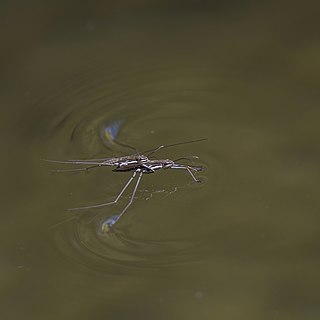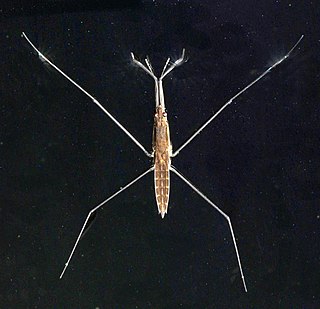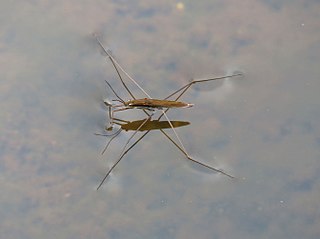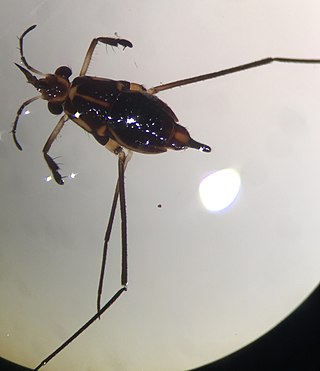
The Heteroptera are a group of about 40,000 species of insects in the order Hemiptera. They are sometimes called "true bugs", though that name more commonly refers to the Hemiptera as a whole. "Typical bugs" might be used as a more unequivocal alternative, since the heteropterans are most consistently and universally termed "bugs" among the Hemiptera. "Heteroptera" is Greek for "different wings": most species have forewings with both membranous and hardened portions ; members of the primitive sub-group Enicocephalomorpha have completely membranous wings.

The Gerridae are a family of insects in the order Hemiptera, commonly known as water striders, water skeeters, water scooters, water bugs, pond skaters, water skippers, water gliders, water skimmers or puddle flies. Consistent with the classification of the Gerridae as true bugs, gerrids have mouthparts evolved for piercing and sucking, and distinguish themselves by having the unusual ability to walk on water, making them pleuston (surface-living) animals. They are anatomically built to transfer their weight to be able to run on top of the water's surface. As a result, one could likely find water striders present in any pond, river, or lake. Over 1,700 species of gerrids have been described, 10% of them being marine.

Veliidae is a family of gregarious predatory insects in the suborder Heteroptera. They are commonly known as riffle bugs, small water striders, or broad-shouldered water striders because the segment immediately behind the head is wider than the rest of the abdomen. Species of the genus Rhagovelia are also referred to as ripple bugs.

Nepidae is a family of exclusively aquatic Heteropteran insects in the order Hemiptera. They are commonly called water scorpions for their superficial resemblance to scorpions, due to their raptorial forelegs and the presence of a long slender process at the posterior end of the abdomen, resembling a tail. There are 14 genera in the family, in two subfamilies, Nepinae and Ranatrinae. Members of the genus Ranatra, the most widespread and species-rich genus, are sometimes called needle bugs or water stick insects as they are slenderer than Nepa.

Water treaders, the superfamily Mesovelioidea, are insects in the order Hemiptera, the true bugs. They are semiaquatic insects that live in moist and wet habitat and on wet plant matter in several types of aquatic habitat.

Halobates or sea skaters are a genus with over 40 species of water striders. Most Halobates species are coastal and typically found in sheltered marine habitats, but five live on the surface of the open ocean and only occur near the coast when storms blow them ashore. These are the only known truly oceanic, offshore insects. They are found in tropical and subtropical marine habitats around the world, with a single species recorded in rivers a few kilometers upstream from the ocean. Halobates are generally very common.

Aquarius remigis, known as the common water strider, is a species of aquatic bug. It was formerly known as Gerris remigis, but the subgenus Aquarius was elevated to generic rank in 1990 on the basis of phylogenetic analysis. Aquarius remigis is found throughout North America, but is most prevalent in the mid-west of the United States.

Aquarius najas, also known as the river skater, is a European species of water strider. It was formerly known as Gerris najas, but the subgenus Aquarius was elevated to generic rank in 1990 on the basis of phylogenetic analysis.
Tachygerrini is a tribe of water striders containing 21 species in 2 genera. In addition to the two extant genera, Eurygerris and Tachygerris, Andersen included the extinct genus Eurygerris within the Tachygerrini.
Tachygerris is a genus of Water Strider.

Tenagogonus is a genus of Water Striders.

Gerroidea is a superfamily of semiaquatic bugs in the order Hemiptera. There are at least 3 families and more than 2,000 described species in Gerroidea.

Aquarius is a genus of water striders found predominantly in the northern hemisphere. Formerly a subgenus, Aquarius was elevated to generic rank in 1990 on the basis of phylogenetic analysis. These are among the world's largest water striders, with females averaging 12–17 mm (0.47–0.67 in) long and males roughly 10–30% smaller, depending on the exact species. An outlier is A. elongatus where both sexes typically are about 24 mm (0.94 in), roughly the same as certain Cylindrostethus, and second only to Gigantometra gigas.

Mesoveliidae is a family of water treaders in the order Hemiptera. There are about 16 genera and at least 50 described species in Mesoveliidae.

Limnoporus is a genus of water striders in the family Gerridae. There are six extant described species in Limnoporus.

Rheumatobates is a genus of water striders in the family Gerridae. There are more than 30 described species in Rheumatobates.

Aquarius conformis is a species of water strider in the family Gerridae. It is found in eastern North America from Quebec west to Wisconsin and south to Florida and Mexico.

Halobates micans is a species of water strider in the family Gerridae. It is one of five Halobates species that live on the surface of the open ocean, only occurring near the coast when storms blow them ashore. Unlike the others that are restricted to the Indian and/or Pacific Oceans, H. micans is circumglobal, occurring offshore in warmer seas around the world. It is the only Halobates species found in the Atlantic Ocean where it ranges from about 40° north to 40° south.















